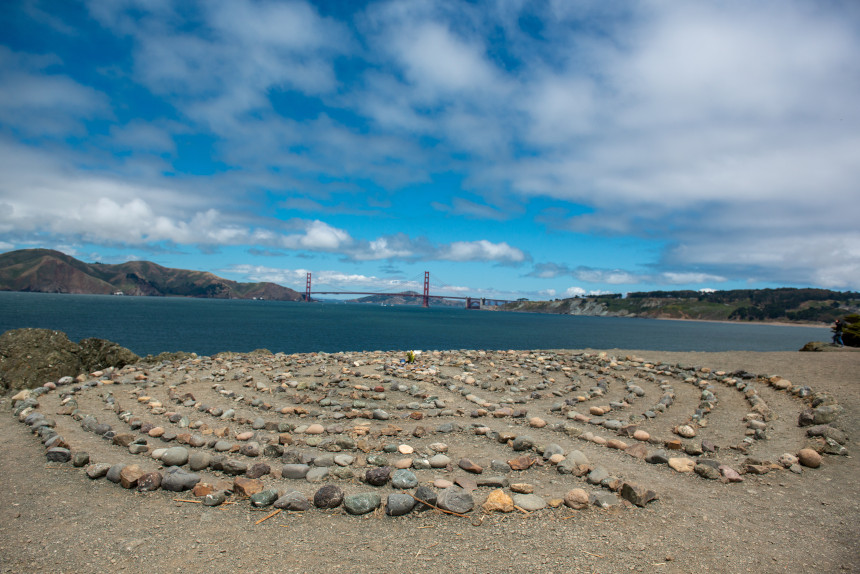This past year has forced us to reckon with every aspect of our lives and find ways to cope with the challenges brought about by the pandemic. While some found solace in sourdough, others devoted themselves to sunrise walks, online yoga sessions, and wellness apps in search of mental, emotional, and spiritual balance.
Humans have searched for meaning and inner peace for centuries. The enlightenment that can be found in labyrinths has been well known from antiquity, and not only to escape Cretan minotaurs.
From the magnificent circular 13th-century labyrinth in Chartres Cathedral in France to the intricate and ephemeral labyrinths created by Oregon-based Circles in the Sand, these tools of transformation offer a path to emotional healing and a way of coping with pandemic life and beyond.
A labyrinth is a narrow, circuitous path with one route leading to a center and out again. It differs from a maze, which is a puzzle containing dead ends and wrong turns, designed to confuse and trick one into getting lost.
According to Jeff Saward, a labyrinth historian based in England, the history of labyrinths goes back 4,000 years, to places in India and Europe, before becoming popularized in ancient Greece and Rome.
With the advent and maturation of Christianity, labyrinths found their way onto the floors of churches, crystallizing into circular formations, including the most famous Medieval labyrinth on the floor of the 13th century Chartres Cathedral in France.

Dating back to 1205, the labyrinth at Chartres Cathedral was first used by monks as a contemplative exercise. As one of the world’s most well-known labyrinthine structures, pilgrims and visitors come from all over the world to experience the meditative power and the redemptive journey of walking its intricately beautiful circular route.
Historically, walking a labyrinth was associated with religious experiences, offering a reflective, spiritual, or devotional pathway in search of the divine. In the 21st century, the appeal of labyrinths has expanded in secular ways, as a means to quiet the mind, achieve meditative peace, and create joyful experiences in the walker.
Labyrinths can be found all over the world. The database of the World-Wide Labyrinth Locator lists more than 6,100 labyrinths in 80 countries, and is searchable by location and type of labyrinth.

For Denny Dyke, labyrinth artist and founder of Circles in the Sand in Bandon, Oregon, labyrinths are powerful representations of well-being, joy, and love.
As the tide recedes past the sea stacks dotting the Bandon coastline, exposing wide swaths of compact sand, Dyke and his team of sand artists and volunteers create traditional circular and more whimsical labyrinth designs each summer season.
Since 2011, Circles in the Sand has produced seasonal labyrinths on the Oregon coast. On average, these labyrinths take 2.5 hours to complete at low tide, where they will stay for up to four hours. As the ocean tide slowly rises, swallowing the shore and erasing the design, the feelings of love and meditative energy linger in the people who’ve experienced the labyrinth.
While temporary in nature, Dyke notes that these labyrinths are born from a lasting “intention of love.”
“As people follow the labyrinth trail, they get a sense of well-being, that everything is okay,” says Dyke. “And that’s reinforced by everybody who’s around them (walking the path), feeling the same thing. It just kind of creates a vortex of that type of energy.”
The labyrinth designs change each session, from circuitous routes to those incorporating inspiration from the sea, such as elaborate mermaids, bulbous seaweed, or sea stars.
As Dyke and his artists mark the design on the shoreline, volunteers use garden rakes to groom the sand in preparation for those idling along the beach, waiting for the chance to walk the labyrinth route.
“I think the benefits of walking a labyrinth remind us as human beings of the importance of taking the time to be with ourselves. There’s no safer place to do that than on a labyrinth. When you’re inside the labyrinth, the rest of the world goes away. Every walk is a little different. But while you’re walking, you’ll always fall into that rhythm, that sense of peace. And that’s what we need right now,” notes Dyke.
Notable labyrinths in the United States include San Francisco’s Land’s End Labyrinth overlooking Mile Rock Beach and the replica Chartres labyrinth inside Grace Cathedral in the city’s Nob Hill neighborhood; and the Glass Labyrinth at the Nelson-Atkins Museum of Art in Kansas City, Mo.

Circles in the Sand’s labyrinth schedule runs from late April to late August. People interested in volunteering to assist Denny Dyke and his team in Bandon can contact him via Circles in the Sand.
Featured image: kovop58 / Shutterstock
Become a Saturday Evening Post member and enjoy unlimited access. Subscribe now



